How cold is Antarctica?
Are you dreaming of an epic expedition to the White Continent, but afraid of facing the cold? Don’t jump ship just yet! While Antarctica harbors the coldest spots on Earth, it all depends on location and timing. With a cold record of -93.2 C (-136 F) measured on the East Antarctic Plateau during the winter, summers on the Antarctic Peninsula can be mild with up to +10 C (50F). What should you expect while planning your epic Antarctic expedition? Read on and find out about the coldest and warmest places on the Southern Continent.
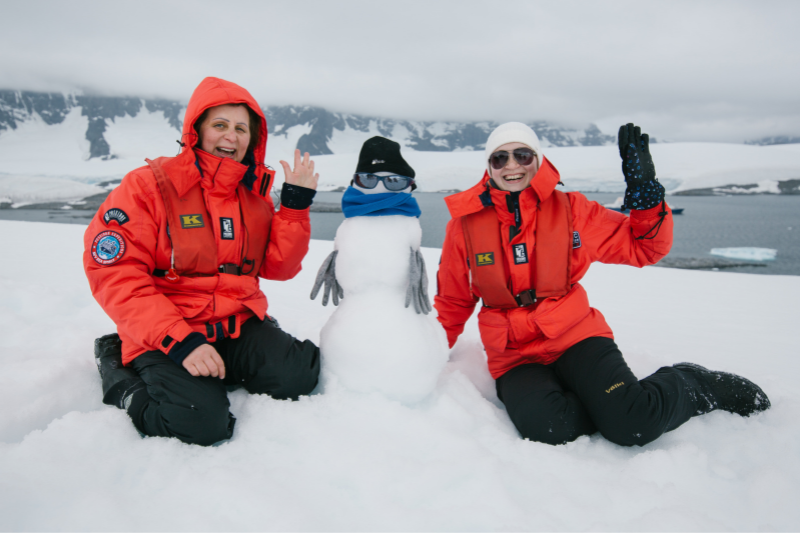
Antarctica’s climate
The White Continent enjoys a very dry climate paired with extreme cold. But how cold and windy it will be and how much snow you should expect depends on your location. The farther north you find yourself, the milder the temperature will be. The Antarctic Peninsula climate generally features milder weather and more precipitation, with an average of 35-50 cm (14-20 inches) per year. In comparison, the interior region features harsher weather and colder temperatures. Continental areas are on average also much drier, with an average of 35cm (14 inches) or less of rain per year.
- Apart from the Antarctic Peninsula, there are several other climate zones around the continent:
- The continental high plateau around the center, featuring high altitudes, extreme cold down to -60 C (-76 F) and rare snowfalls
- The continental low plateau (low altitude in West Antarctica, as well as coastal East Antarctica), featuring very cold temperatures year-round down to -35 C (-31 F), with heavy snowfalls, winds and blizzards
- The continental high latitude (coastal areas far south from 70 degrees latitude south), with temperatures as low as -30 C (-22 F), changing weather and snow
- The continental low latitude (coastal areas around 65 to 70 degrees latitude south), temperatures as low as -20 C (-4 F) and cold summers due to snow and ice cover
- The Antarctic islands, with a maritime climate similar to the Antarctic Peninsula The subantarctic islands, located above the sea-ice limit, with cool summers, mild winters and temperatures as low as -1.5 C (29 F)
Climate change affects Antarctica’s ice sheets. The carbon dioxide and greenhouse gas emissions cause a continuous rise in temperatures, especially around the pole, which causes glaciers to melt rapidly. Antarctica climate is crucial for the planet’s heat balance, as its ice sheets are reflecting sunlight back into space (in comparison to land or water surfaces that are absorbing, rather than reflecting, light).
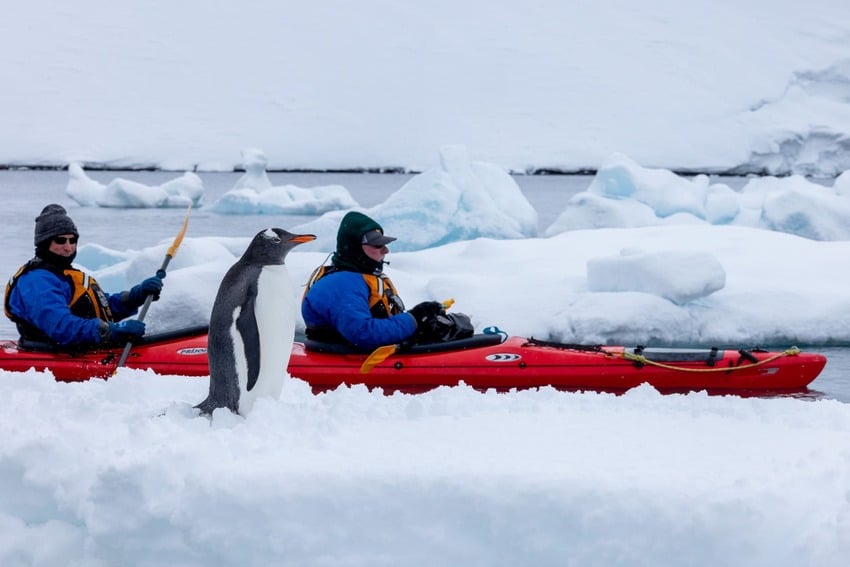
What is the lowest temperature ever recorded in Antarctica?
The East Antarctic Plateau holds the current world record. On August 10th, 2010 an area near the ridge between the Dome Argus and Dome Fuji summits measured a whopping -93.2 C (-136 F). Thanks to satellite data, researchers were able to obtain these new record numbers. Prior to that the Russian Vostok Research Station in East Antarctica held the world record with -89.2 C (-128.6 F) measured on July 21st, 1983.
What is the highest temperature ever recorded in Antarctica?
Summer in Antarctica can be quite pleasant. It’s the perfect time for expeditions, cruises and staff turnover at research bases. The highest temperatures on the Antarctic mainland was recorded at the Esperanza Base (Argentina) at 18.3°C (64.9°F) on February 6th, 2020.
.jpg)
What is the average temperature in Antarctica?
What’s the weather in Antarctica like? Temperatures vary a lot throughout the continent! Winter temperatures can be gruesomely cold. Whether you experience a light nip or a bone-chilling freeze will depend on when you visit, where you go and, of course, how well you’re dressed.
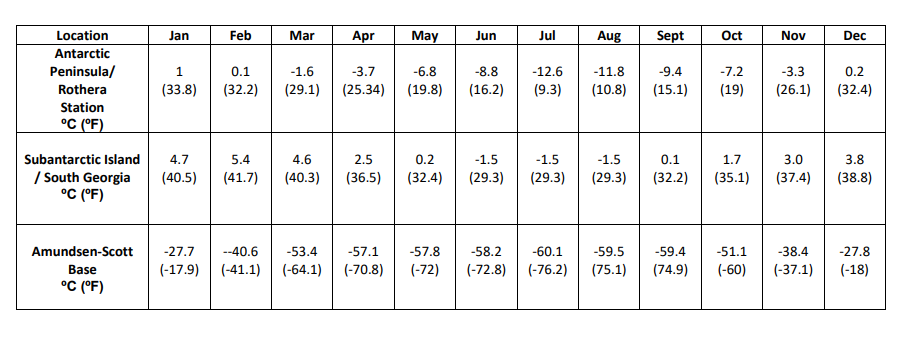
Average monthly temperatures, source: www.coolantarctica.com and www.amundsen-scott.climatemps.com.
Antarctica’s weather
A visit in winter may be far less enjoyable than during the summer months. While the Antarctic Peninsula stays relatively mild even during the winter with around -12°C (10.4°F), the average temperature across Antarctica is -34.4°C (-30°F). Thick sea ice surrounds the continent in winter, which makes it difficult for ships to reach the continent. Add to that strong winds with speeds of around 100km/h (62 mph) and blizzards that sweep the continent. The highest wind speed ever recorded was 320km/h (nearly 200mph). Only a few people spend winters in Antarctica on research bases across the continent, celebrating midwinter on June 21st, when the sun is the furthest away from the South Pole.
Its proximity to the ocean and location farther north gives the Antarctic Peninsula a very comfortable maritime climate, perfect for exploring and spotting an abundance of wildlife. It’s the perfect place for any traveler wanting to cruise in a Zodiac boat, hike on land and discover marine mammals and rare seabirds. The average temperature during prime cruising season is around 0 degrees Celsius (32 Degrees Fahrenheit).
Antarctica's weather in summer?
f you’re hoping for a warm trip, Antarctica may not be the prime location for you. While Antarctica has two seasons (winter and summer), even in the summer and around the warmest parts (like the Antarctic Peninsula) the temperatures will mostly be just around +10 C (50 F). If you travel to the White Continent, be prepared for all contingencies – Antarctica weather is unpredictable and changes quickly! While keeping track of the forecast may be a good idea, you can expect “to roast” in the sun in one moment, and freeze in cold and windy weather a few minutes later.
Antarctica's weather in winter?
A visit in winter may be far less enjoyable than during the summer months. While the Antarctic Peninsula stays relatively mild even during the winter with around -12°C (10.4°F), the average temperature across Antarctica is -34.4°C (-30°F). Thick sea ice surrounds the continent in winter, which makes it difficult for ships to reach the continent. Add to that strong winds with speeds of around 100km/h (62 mph) and blizzards that sweep the continent. The highest wind speed ever recorded was 320km/h (nearly 200mph). Only a few people spend winters in Antarctica on research bases across the continent, celebrating midwinter on June 21st, when the sun is the furthest away from the South Pole.
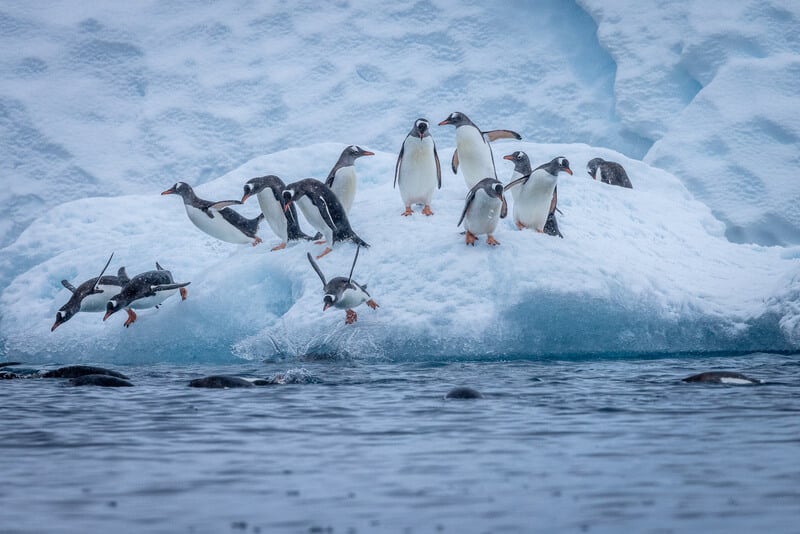
Why is Antarctica so cold?
Exposure to sunlight: The poles receive very little direct sunlight. Even during the Antarctic summer months, the sun is low on the horizon and not as strong as in places closer to the equator. Considering the sloped angle in which sunlight travels to Antarctica, it has to penetrate further through the atmosphere, thus weakening its powers. By the time rays of sunlight arrive on the White Continent, they are too weak to significantly heat up its surface.
Altitude: An average elevation of 2,500m (8.200 ft) makes Antarctica the highest continent in the world. With a higher altitude comes a lower temperature average across the continent.
Reflection: Ice and snow reflect the light and divert it back to space. This functions as a coolant for Antarctica.
High winds: It’s really windy in Antarctica and the wind chill makes the already cold air feel even colder.
Wind in Antarctica
Why is Antarctica so windy? Surrounded by a belt of low pressure (circumpolar through), the interior features a high-pressure system. As cold dense air flows from the interior down the steep coasts of Antarctica, katabatic winds form. The low pressure near the coasts can increase the strength of winds coming from the interior with gusts over 200km/h (125mph).
Precipitation
Antarctica is not only the coldest, but also the driest continent on the planet. While only coastal areas experience rain, mostly it comes in the form of snow or airborne ice crystals. An average of 150mm of precipitation (mostly in the form of snow) is measured pear year, with over 200mm on the coast and only 50mm annually on the plateau.
Drifting and blowing snow
With Antarctica being so windy, it can even be difficult to measure precipitation properly because the winds pick up snow and carry it across large distances. Snow that is carried by wind at lower speeds of ca. 30km/h (19mph) below eye level is called drifting snow, whereas snow carried above eye level at speeds above 60km/h (37mph) is considered blowing snow.
Blizzards
What’s the difference between blizzards and snowstorms? For the average amateur explorer these may sound just the same – a large amount of snow blowing into your face. But ask the historic Antarctic explorers like Roald Amundsen, Robert Falcon Scott, Douglas Mawson or Sir Ernest Shackleton and they will tell you that a full-blown blizzard may determine whether you live to tell your heroic stories or perish on the White Continent.
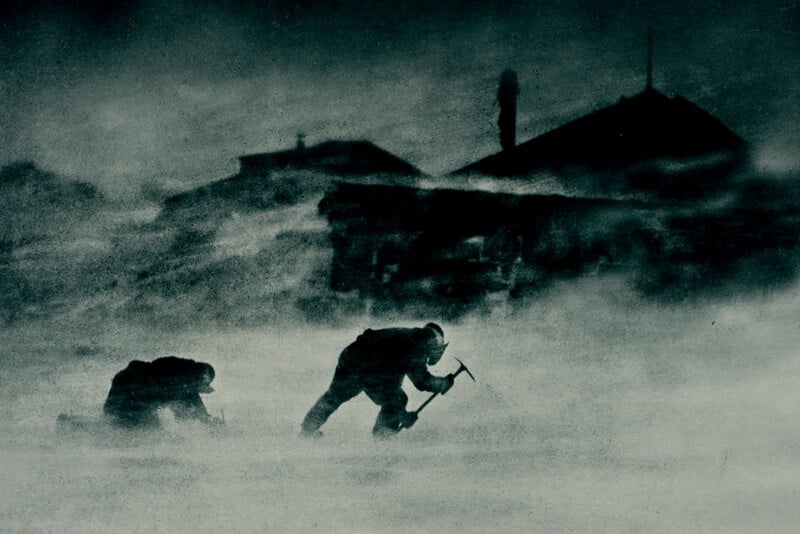
Antarctic expedition 1911. Photo by Frank_Hurley
Whiteout
For someone who hasn’t been to Antarctica, it can be hard to fully comprehend how cold it really gets. We’ll try to give you an idea by comparing Antarctic temperatures to other famously cold and wintery locations:
· Skiing during the winter holidays in Courchevel (France): - 1°C to -10°C (30°F -14° F)
· Reaching Uhuru Peak, the top of mount Kilimanjaro (Tanzania): -7°C to -29°C (20°F to -20°F)
· Spending a dark winter holiday with the polar bears in Longyearbyen (Svalbard): -8°C to -14°C (18°F to 7°F)
· Working your January shift on an Alaskan oil field in Prudhoe Bay (USA): -25°C to -32°C (13°F – 26°F)
· Ascending mount Everest during the prime climbing season in May (and actually reaching the summit): ca. -26°C (-15°F)
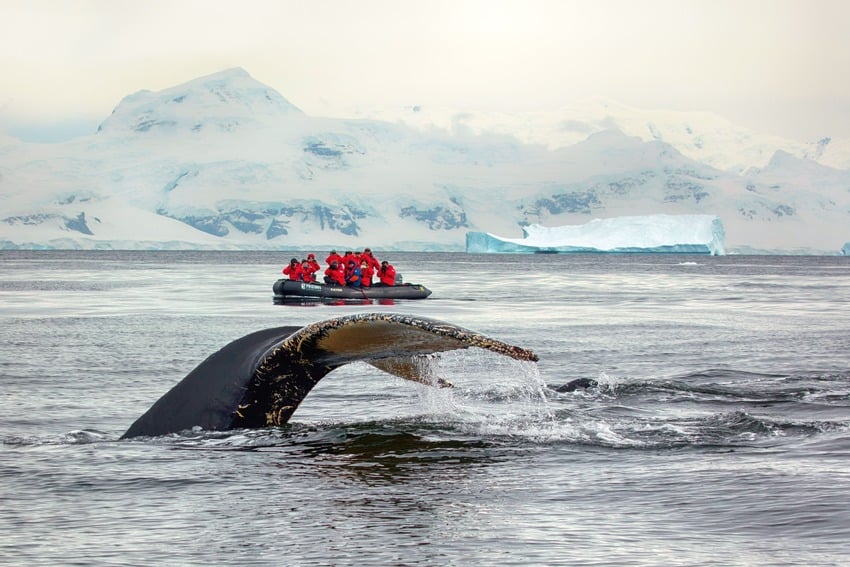
FAQ
1. What's the warmest it gets in Antarctica?
The coldest temperatures in Antarctica are usually found on the plateau and around the South Pole, away from the coasts. You can experience the warmest Antarctic weather with temperatures of up to +10 C (50 F) on the Antarctic Peninsula during the Antarctic summer (November-March). Summers on the South Pole at the Amundsen-Scott station are around -18 C (0 F). Antarctic cruises usually journey close to the peninsula (not to the cold Antarctic Plateau), thus promising a moderate summer temperature while you explore.
2. What is the coldest place on Earth?
The lowest temperature ever recorded was measured on the East Antarctic Plateau on August 10th, 2010 at -93.2 C (-136 F). Antarctica weather in summer (for example around the South Pole) is still quite chilly at around -28 C (18 F).
3. What are the coldest temperatures in which humans survive?
While it all depends on what kind of protection you have available (clothes, tent, vehicle or shelter), the cold records among permanently inhabited places on Earth were measured in the city of Snag (Canada) at -63 C (-81 F), Utqiagvik (USA/Alaska) at -49 C (-56 F) and Oymyakon (Russia) at -72 C (-97 F). People in these regions are well adapted to the cold and know about the danger of hyperthermia and how to avoid getting yourself stranded outside, exposed to the elements.
4. Does anything grow in Antarctica?
No. Even though around 90 million years ago the White Continent was home to a lush rain forest, currently there is no flora in Antarctica with the exception of Antarctic hair grass and pearlwort found on the South Orkney and South Shetland Islands.
5. Which pole is colder?
The South Pole. The ice sheet of Antarctica around the South Pole is at a 2,700 m (9,000 ft) elevation, which makes for colder temperatures. The North Pole is located in the ocean and water retains heat better than land.